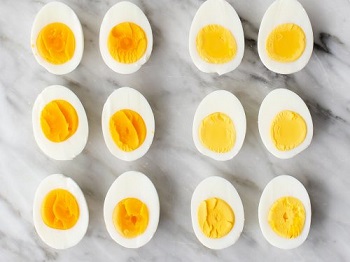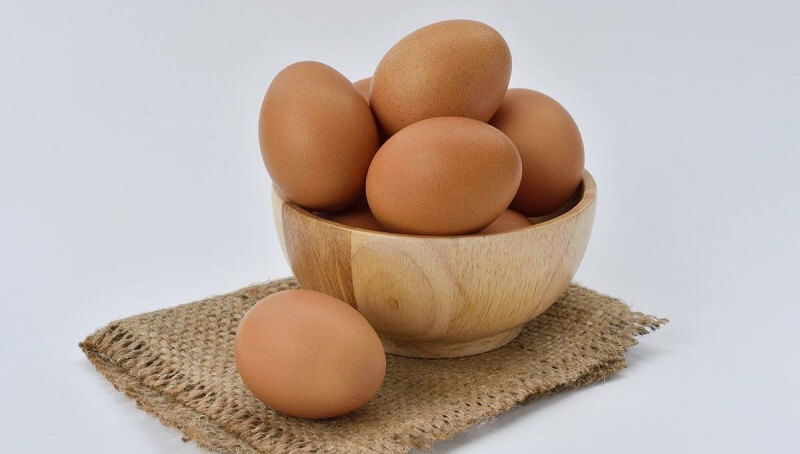Did you ever wonder how many eggs do you actually need when a recipe will call for just one cup of egg whites for example? How many eggs can you actually fit in a cup of egg whites? This is just one question about eggs that we tackle in this article.
You can usually use eggs in one of the next three ways when using them as ingredients in recipes: either egg yolks, egg whites, or whole eggs. The size of the egg will be just one of the factors that will ultimately influence the volume of the egg. Although most recipes call for either large or medium size eggs, we went for the normal eggs that you find in most grocery stores for our research, as these are the ones people will usually buy. So let’s answer this question: what is the volume of an egg?
We first needed to find out how much yolk would an average to large egg hold and how much egg white would the same egg have. Having this information would make it a lot easier to figure out the total volume of that particular egg. It might come as a surprise but, you will usually get 2 tablespoons of egg white and anywhere between 1 and 1.25 tablespoons of egg yolk in your average egg. This means that a whole egg, including the shell, would be around 3 tablespoons in volume. For the same egg, its egg white would weigh around 1 ounce/30 grams, while the yolk sat at about .6 ounce/18 grams.
Some recipes will call for a number of cups of eggs. So how many eggs will fit in a cup? The answer is pretty simple. An average cup will hold about 4 large whole eggs. You will also be able to fill a cup with just the yolks if you add around 13 egg yolks. As for the egg whites, around 8 egg whites should be enough to fill a cup.
Interesting fact: There is a connection between what food will the hen eat and the color of her yolks. Also, the breed of the hen will be responsible for the shell color and not the nutritional value or the quality of the egg. The eggs from a hen will become larger and larger as she grows and in general, one hen will be able to lay around 250 to 300 eggs each year.
You should also know that you can check whether an egg is hard-cooked or raw with ease: all you have to do is spin it and if it spins easily, then it is cooked. If it wobbles instead, then it is raw.
The information provided up to this point should make it easier for you to follow recipes that require the use of eggs and call for a particular volume of eggs or a number of egg cups. You can also use the converter we provide below for even easier egg measurements. To separate the eggs for recipes that call for this, you can also buy an egg separator.
General Information on How to Store an Egg
You should always store eggs in their original carton to prevent them from absorbing odors from other foods while in the refrigerator.
Along with the usual brown or white chicken eggs, in most stores, you will also find goose eggs, which are considerably larger and stronger in flavor than chicken eggs, quail eggs that are considerably smaller than chicken eggs and will usually be used as hors d’oeuvres or in some specialty recipes, and duck eggs.
Long Term Storage
 If you want to freeze the eggs, you can crack each one and beat it until it is blended then put the mixture from each egg into a separate muffin tin compartment and then freeze the tin. As soon as it is frozen, take the muffin tin out of the freezer, pop each of the muffin areas and place the hardened mixture in a plastic freezer bag. When it’s time to use the mixture, remove how much you need and thaw in the refrigerator.
If you want to freeze the eggs, you can crack each one and beat it until it is blended then put the mixture from each egg into a separate muffin tin compartment and then freeze the tin. As soon as it is frozen, take the muffin tin out of the freezer, pop each of the muffin areas and place the hardened mixture in a plastic freezer bag. When it’s time to use the mixture, remove how much you need and thaw in the refrigerator.
If it seems more OK for you, you can even beat the eggs together and then place the mixture in an airtight plastic container and freeze all the eggs together. When it’s time to use frozen eggs you will use around 2 tablespoons of the blended mixture to have the same volume as for one large egg.
Short Term Storage
You should always eat the eggs within a maximum of 1 week since you purchased them. Eggs in general will keep for around 5 weeks before they lose their functional properties and nutrients but you can’t really know how long has passed since they were made, so it’s always better to check them for freshness before eating or adding them to recipes.
You might also like our articles about corn, celery, or sweet potatoes.
Did You Know?
- Contrary to popular belief, you will not build muscle eating raw eggs. Although 91% of the proteins from cooked eggs will be digestible, when it comes to raw eggs, only 51% of their proteins will be absorbed by your body.
- Most of the eggs you will nowadays see in the store will come from just two types of hens: the Barred Plymouth Rocks that produce brown eggs, and the White Leghorns, which produce white eggs.
- One of the most important reasons why white eggs are more prevalent in stores and among producers is because chickens that lay white eggs are usually considerably smaller than brown egg-layers, which means they require fewer expenses for the same number of eggs.
- Did you even think about why we eat chicken eggs and not turkey or duck eggs? Turns out there are a few reasons to do so: Ducks and turkeys lay fewer eggs in general and have stronger mothering instincts compared to chickens, which makes egg collection really hard. Chickens also need less space for nesting and living in general.
- Chickens produce several eggs at the same time, each in a different stage of development. This means that most chickens won’t produce one egg at a time.
- Developing an egg will take around 24 to 26 hours for the usual hen. As soon as one egg pops out, the new egg will start developing within a maximum of 30 minutes.
- The largest egg in the world was made by a hen from the United Kingdom called Harriet. That particular egg measured around 9.1 inches in diameter.
Conclusion
Eggs aren’t only eaten whole as part of a healthy breakfast. They are vital in a lot of recipes because they help with ingredient binding, act as an emulsifier and thicken the food.
Don’t pick the eggs based on their shell color, as this has no impact on the actual amount of nutrients, quality of flavor of the egg. The color is determined in full by the breed of the chicken.
